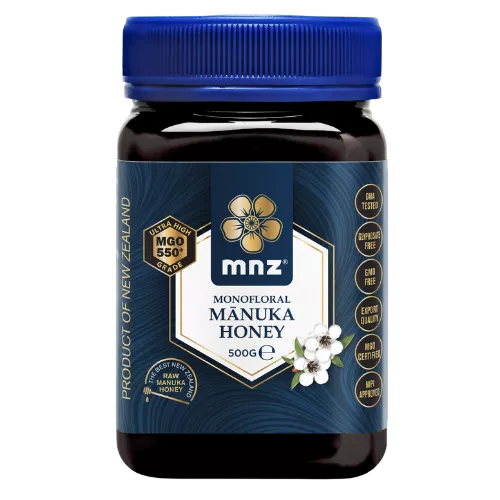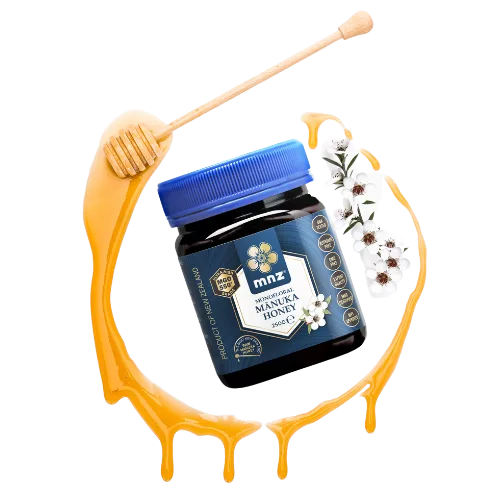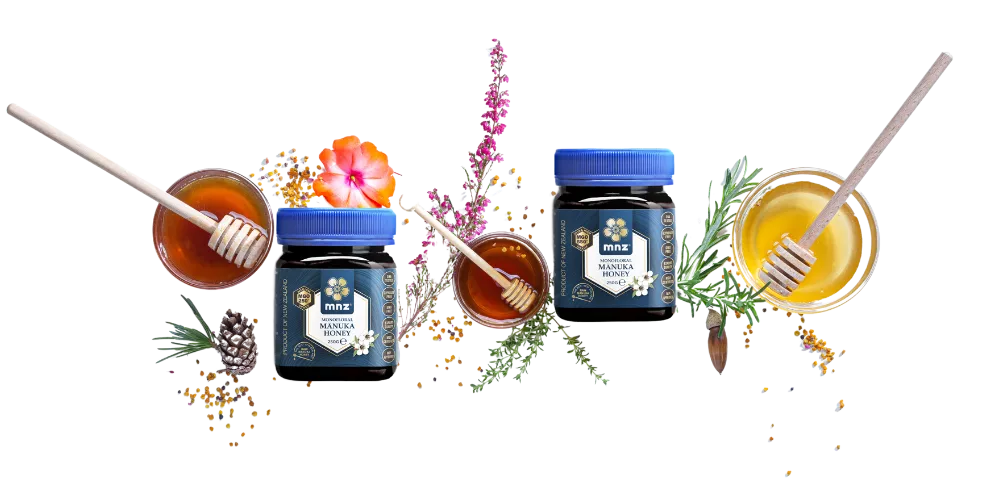Manuka honey, sourced from the Leptospermum Scoparium or the Manuka tree, holds a special place in the world of honey due to its extensively researched and recognized unique, high-quality, natural bioactivity. This exceptional type of honey has garnered attention from leading universities globally, making it the first honey to be studied so thoroughly for its distinctive properties. The rarity of Manuka honey is due to its limited production period, as it is only harvested for a few weeks each year when the Manuka tree blossoms. It's during this brief flowering period that the bees collect nectar from the Manuka flowers, giving rise to honey that possesses a unique combination of the age-old benefits of honey and the potent properties of the New Zealand Manuka tree. What truly sets Manuka honey apart is the synergy between its complex composition and the unparalleled New Zealand environment. New Zealand's pristine natural ecosystems, coupled with its clean waters, pure air, and diverse climatic conditions, contribute to the growth of robust and resilient plants and trees, including the native Manuka tree. These environmental factors play a crucial role in the development of the Manuka tree, enabling it to produce the special natural compounds that are integral to the unique qualities of Manuka honey. In essence, Manuka honey's distinctiveness and richness are a direct reflection of New Zealand's unique location and its natural, unspoiled environment. This synergy results in Manuka honey being one of the most sought-after and prized honeys in the world, valued not just for its taste but also for its remarkable natural properties.

New Zealand Manuka Honey stands out as the only 100% natural food globally that has been scientifically proven to possess a unique, high-quality, and natural bioactivity. This distinctive characteristic has earned it a reputation as one of the most unique foods in the world, making it suitable for consumption by individuals aged one year and older.
One of the notable aspects of Manuka Honey is its moderate glycemic index, which ranges between 54 and 59. This feature is particularly beneficial for diabetics, as it allows them to enjoy Manuka Honey while carefully managing their blood sugar levels. Its moderate glycemic index means that it does not cause rapid spikes in blood sugar, making it a safer option in comparison to foods with higher glycemic indices.
Furthermore, the versatility of Manuka Honey extends beyond human consumption; it is also suitable for animals. This makes it a valuable addition to various dietary regimens, catering not only to the nutritional needs of people but also to those of animals.
In summary, New Zealand Manuka Honey's scientifically backed bioactive properties, along with its suitability for a wide range of consumers, from young children to diabetics and even animals, underscore its uniqueness and versatility as a natural food product.
Raw Manuka Honey truly embodies the essence of nature's intent. It represents Manuka Honey in its purest form, remaining unaltered by processing, pasteurization, or heat treatment. This commitment to maintaining its natural state preserves several key characteristics that distinguish raw Manuka Honey:
Preservation of Nutrients; Raw Manuka Honey retains its vitamins, minerals, and nutrients just as nature intended. This means that the beneficial compounds naturally found in honey remain intact, offering potential health benefits to those who consume it.
Higher Natural Enzyme Content; Raw honey, including Manuka Honey, boasts a higher natural enzyme content compared to processed honey. These enzymes can contribute to the honey's bioactivity and potential health-promoting properties.
Elevated Amino Acid Profile; Amino acids are the building blocks of proteins and play essential roles in various bodily functions. Raw Manuka Honey contains an elevated amino acid profile, which can be valuable for those seeking a nutrient-rich natural sweetener.
Thicker Consistency; Raw honey, including raw Manuka Honey, typically has a thicker consistency compared to processed honey. This texture adds to its unique character and makes it a popular choice for various culinary applications.
Slightly Grainy Texture; The grainy texture of raw honey is a natural occurrence and is not indicative of spoilage. It adds an interesting element to the honey's sensory experience, distinguishing it from smoother honey varieties.
Incredible Aromas and Natural Flavor Profile; Raw Manuka Honey is known for its captivating aromas and authentic, natural flavor profile. These sensory attributes are appreciated by those who enjoy its unique taste.
In summary, raw Manuka Honey is a testament to preserving the inherent qualities of this exceptional honey variety. Its natural state ensures that it remains a source of potential health benefits and a culinary delight for those who savor its distinctive characteristics.
Read more about the difference between raw and creamed honey.
MGO, short for Methylglyoxal, is a naturally occurring substance found in Manuka Honey. It is a unique and significant component that contributes to the special properties of Manuka Honey. MGO forms within the honey during the process of nectar collection and conversion into honey, primarily due to the presence of DHA (dihydroxyacetone).
Here's a brief explanation of how MGO is produced in Manuka Honey:
Nectar Collection: Bees collect nectar from the blossoms of the Manuka tree (Leptospermum scoparium). This nectar contains the natural precursor, dihydroxyacetone (DHA), which is present in the nectar as a result of the plant's metabolism.
Conversion to Honey: The collected nectar is then brought back to the hive, where it undergoes a transformation process. Enzymes in the bees' digestive system convert DHA into Methylglyoxal (MGO) as part of this process.
MGO Accumulation: Over time, MGO levels increase in the honey as a result of this enzymatic conversion. The concentration of MGO in the honey depends on several factors, including the nectar's initial DHA content and the enzymatic activity of the bees.
The presence of MGO is one of the key markers used to assess the quality and authenticity of Manuka Honey. It is associated with the honey's unique bioactivity and potential health benefits. The higher the MGO content, the more bioactive the Manuka Honey is considered to be.
Manuka Honey is known for its distinct MGO content, which sets it apart from other types of honey. It is one of the factors that contribute to the honey's reputation for natural bioactivity and its various applications, including its use in traditional and modern wellness practices.







MNZ provides a helpful guideline for choosing the right Manuka Honey based on its MGO (Methylglyoxal) value, which reflects the honey's unique, high-quality, and natural bioactivity. Here's a summary of the recommended MGO values and their potential uses:
MGO 100+
Suitable for daily use, particularly during breakfast. It offers general support for overall health and wellness.
MGO 250+
Designed for daily use with added support for the stomach and intestines. Athletes may find this variant beneficial.
MGO 400+
Provides mild support for the stomach and intestines. It is also suitable for skincare purposes and can be used during the winter months.
MGO 550+
Offers powerful support for stomach and intestinal health, including conditions like heartburn. It's also ideal for addressing skin issues and slow-healing wounds.
MGO 1000+
Known for its very unique natural bioactivity, this variant provides robust support for the body's overall well-being.
MGO 1200+
Considered to have special high-quality natural bioactivity, it offers powerful support for the stomach and intestines and is ideal for addressing skin concerns.
MGO 1500+
The best of the best
It's important to note that all MGO values of Manuka Honey are suitable for individuals aged 1 year or older. Contrary to a common myth, there is no need for the body to gradually get used to higher MGO values. MNZ's Manuka Honey products can be easily incorporated into daily health routines, whether you lead an active or passive lifestyle.
You can consume these Manuka Honey variants directly from the spoon on an empty stomach or dissolve them in lukewarm water. Choosing the right MGO value depends on your specific health needs and preferences, allowing you to enjoy the potential benefits of Manuka Honey in a way that suits you best.
Manuka Honey from MNZ is a versatile product with a wide range of applications. Here are some common ways to use it:
Consumption
- You can consume Manuka Honey directly on an empty stomach for its potential health benefits.
- It can be dissolved in water, making it a natural addition to your sports drink for added energy and potential recovery benefits.
- Manuka Honey can be incorporated into your meals, including breakfast, lunch, and dinner, to enhance the flavor and nutritional value of your dishes.
Topical Use
- Manuka Honey can be applied directly to the skin for various purposes:
- It can be used on wounds that are slow to heal to potentially promote faster healing.
- Manuka Honey may be applied to acne-prone skin or other inflamed skin conditions for its potential anti-inflammatory and antibacterial properties.
These applications make Manuka Honey a versatile and valuable addition to both your dietary and skincare routines. It's important to choose the right MGO value based on your specific needs, as different variants offer varying levels of unique, high-quality, and natural bioactivity.
Manuka Honey's unique properties, particularly its high levels of Methylglyoxal (MGO), have indeed been the subject of extensive research by scientists and researchers around the world. Here are some key points regarding the research and individuals involved.
Discovery of MGO
In 2006, German scientists, led by Professor Thomas Henle from the Technical University of Dresden, made a significant discovery. They found that the exceptionally high levels of Methylglyoxal (MGO) in Manuka Honey are responsible for its high-quality, unique, and natural bioactive properties. This discovery shed light on the key component that sets Manuka Honey apart
Professor Peter Molan
Professor Peter Molan, affiliated with the University of Waikato, played a pivotal role in researching the special effects of Manuka Honey. His work in this field dates back to 1985 when he began studying Manuka Honey's unique properties. He collaborated with the Waikato Honey Research Unit and made significant contributions to understanding the medical applications of Manuka Honey. His research resulted in numerous scientific publications, primarily focused on the medical field, and earned him recognition for his work. Professor Peter Molan worked closely with Professor Thomas Henle.
Scientific Publications
Over the years, there have been many scientific publications that have explored and documented the unique properties of Manuka Honey. These publications have contributed to the growing body of knowledge surrounding Manuka Honey's potential health benefits and applications.
The collaborative efforts of researchers like Professor Thomas Henle and Professor Peter Molan have significantly advanced our understanding of Manuka Honey and its natural bioactivity, making it a subject of interest in the scientific community.
Manuka Honey has undergone extensive research at prestigious global research institutions, investigating its exceptional bioactive properties. Peter Molan has dedicated his research efforts to exploring the distinctive characteristics of Manuka Honey since the 1990s, resulting in multiple scientific publications. Furthermore, in 2006, Thomas Henle's groundbreaking discovery highlighted the significant role played by naturally occurring MGO in enhancing the bioactive potential of Manuka Honey.
MNZ takes pride in crafting all of its products using exclusively sourced raw Manuka Honey, carefully produced, packed and labeled within the pristine landscapes of New Zealand.

Throughout history, honey has enjoyed a rich legacy as a nourishing food. Raw Manuka Honey seamlessly integrates into a health-conscious lifestyle, preserving its natural composition with vitamins, minerals, and nutrients, along with an enriched content of natural enzymes and a robust amino acid profile. Its distinctive qualities include a thick consistency, a subtly grainy texture, and a captivating array of aromas and an authentic flavor profile.
Manuka Honey boasts a versatile array of applications, serving as a delectable food source, a valuable component of sports nutrition when blended into sports drinks, a contributor to gastrointestinal well-being, and a soothing agent when applied to the skin to alleviate irritations and acne. Its renowned bioactive properties make Manuka Honey a delightful indulgence for the body.
No. That is a short and sweet answer because more Manuka honey is consumed than produced. All raw Manuka Honey from MNZ undergoes a rigorous series of analyzes before the final product is prepared for consumption. All information about our Quality Guarantee can be found at MNZ Quality guarantee.
No. It is up to the producer to determine whether the honey remains raw or whether it is processed into a cream honey. MNZ produces ONLY raw Manuka honey.

Raw Manuka honey
As nature intended, pure, raw, unprocessed, unpasteurized, and unheated honey has a tendency to naturally crystallize over time, which is a beneficial occurrence. Honey is essentially a super-saturated sugar solution, containing over 70% sugars and less than 20% water. This means that there is more dissolved sugar than can naturally be held in solution at room temperature. In the warm environment of the hive, at around 35°C, honey sugar remains stable in its dissolved form. However, when exposed to lower temperatures, the sugar in honey forms crystals, causing the honey to solidify.
The process of honey crystallization plays a vital role in preserving the rich flavor and quality characteristics of honey. Crystallization can take various forms, with some honey crystallizing uniformly and others forming distinct layers, with the crystallized portion settling at the bottom while the top remains liquid. The size of the crystals depends on the type of honey, ranging from small, uniform crystals to larger, granular ones. The speed at which honey crystallizes affects its texture, with faster crystallization resulting in a finer texture.
Crystallized honey appears lighter in color and more opaque compared to its liquid form. This change occurs because glucose, one of the two main sugars in honey (along with fructose), has a lower solubility and tends to crystallize first. Additionally, the crystal size can be influenced by the specific region in New Zealand from which the Manuka Honey originates.
Raw Manuka honey, due to its natural properties, tends to be harder than average honey. The presence of white residue or crystallization in raw Manuka honey is a common characteristic of raw honey and is indicative of its natural crystallization process. To return it to its liquid state, one can gently warm the honey in hot water (up to a maximum of 35°C).
Centrifugation is the traditional method used to extract honey, effectively removing larger wax particles and minimizing impurities. This process ensures that honey remains unexposed to heat, preserving its natural properties throughout production.
Characteristics of raw honey
The natural integrity of raw Manuka honey ensures that its vitamins, minerals, and nutrients remain fully intact. It boasts a higher content of natural enzymes and a rich amino acid profile. As a result, raw Manuka honey has a thicker consistency, with a slightly grainy texture that adds to its unique character. Its flavor is characterized by incredible aromas and a natural flavor profile that captures the essence of its source.
The 4 production steps of raw MGO Manuka Honey:
Step 1 uses a cold extraction method (max 35° C) to extract the honey from the honeycombs
Step 2 is to collect the honey in large honeycombs
Step 3 is to lightly filter the honey to remove any stray / covering wax and bee residue
Step 4 is to fill the jars with pure, raw, unprocessed, unpasteurized and unheated Manuka honey
MNZ produces only raw, unfiltered, unpasteurized, monofloral manuka honeys in BPA-free containers and are produced, processed and packaged in New Zealand.

Cream of Manuka Honey
Honey can also undergo a process called "creaming" to control the formation of crystals artificially. This process, known as homogenizing, aims to create a uniform structure and composition throughout the honey while reducing it to small, evenly distributed particles. Creaming also introduces aeration to the honey. The result is a honey with exceedingly fine crystals, less than 25 microns (0.025 mm) in size, which maintains a smooth and spreadable texture indefinitely.
The creaming process involves the meticulous mixing of "seed honey," which contains extremely fine crystals, with liquid honey that acts to prevent the formation of larger crystals. This mixing process is carefully temperature-controlled to achieve the finest granular honey. Over time, the honey naturally crystallizes, with the ideal crystallization temperature being 16-18°C. At higher temperatures, crystallization occurs more slowly, leading to larger crystals.
To reverse the crystallization process, honey can be heated to a temperature between 40°C and 65°C and held at that temperature for several days, causing it to transition from a crystallized state back to a liquid one. Specialized honey cream machines employ mechanical mixers designed for the recrystallization process, resulting in honey with an ideal spreadable consistency, reminiscent of children's chocolate spreads.
This process involves cyclic aeration and intensive mixing over several days until the desired consistency is achieved. For instance, crystallized honey can be added to liquid honey at the beginning of the process. The goal of "creaming" is to create numerous small crystallization nuclei while preventing the growth of existing honey crystals. Honey kept at a constant temperature after this process retains its creamy consistency for many months.
On the other hand, centrifuging honey with increased heat yields a higher quantity of extracted honey. During this process, larger wax pieces are removed and then carefully poured to prevent impurities and the retention of small wax particles in the honey post-centrifugation.
Pressure filtration is another industrial filtration process that some producers use, but it is counterproductive for honey. This process, resembling pouring, heats honey and pumps it through tiny microfilters at high speeds, packaging it directly into containers, similar to soft drinks. However, this process can alter the honey's natural state and result in the loss of some nutrients and properties, as the fine meshes used can trap or eliminate certain elements.
Pasteurization is yet another method for processing honey. During pasteurization, honey is exposed to high temperatures, leading to the loss of nutrients and the destruction of enzymes sensitive to heat. In the case of honey, preserving its natural state is paramount, as changes in properties, such as the diastase enzyme, can occur due to the heat, making this process less favorable for honey.
The 8 production steps of cream Manuka Honey:
Step 1 is to use an extraction method between 40° C - 65° C to extract the honey from the honeycombs
Step 2 is to collect the honey in large honeycombs
Step 3 is to filter the honey to remove any stray / covering wax and bee residue
Step 4 is to filter the honey to 200 microns (0.2 mm) to remove even more
Step 5 is to increase the temperature to 40° C - 65° C to create an even more fluid honey (HMF increases!)
Step 6 is to aerate / stir the honey for up to from 3 days to 2 weeks
Step 7 is to mix the honey for 10 to 15 minutes several times a day and cool it back to 12-15°C
Step 8 is to fill the jars with creamed manuka honey